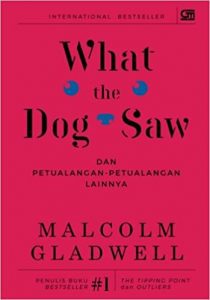
What the Dog Saw is essentially a collection of 19 articles that were all previously published on the pages of The New York Times. These are a collection of Malcolm Gladwell’s best articles.
Through these features, Gladwell seeks to showcase the world through the eyes of others, other business people, geniuses or even alcoholics or dogs. The collection is an interesting mix of finance, marketing, psychology, cultural history, and sociology. He covers a wide range of topics in this book which transforms readers into diverse individuals.
Here are a few examples of what you can explore in What The Dog Saw:
1. Pioneers, and Other Varieties of Minor Genius
This is the first section of the book and it includes six essays. In the words of Gladwell, this section is about “obsessives” and what he likes to call “minor geniuses”. These are not Einstein, Winston Churchill or Nelson Mandela or the other prominent shapers of the world but people like Ron Popei and Shirley Polykoff.
2. The Pitchman:
The Pitchman narrates the tale of an excellent inventor. Malcolm explores who he is and what people like him generally tend to be like. He relates these characters to actors. A resolve is found between their similar personalities in the end.
3. The Ketchup Conundrum:
The Ketchup Conundrum illustrates how food and beverage commodities are researched, developed, manufactured, and sold. This section is about ketchup vs mustard. Ketchup emerges as one of the few products that sell without the need to diversify like mustard. The author looks into the significance of concentrating on a single objective instead of diversified objectives.
4. Blowing Up:
Blowing Up offers 2 methods of investing in the Stock market. He urges investors to discover patterns and always bank on chaos.
5. True Colors:
True Colors examines and reveals the marketing tools used by hair dye companies(Clairol and L’Oreal) to grab the American woman’s interest. It also describes how campaigns led by women throughout the decade were always crucial in the types of trends that dye companies gravitated towards.
6. John’s Rock Error:
John’s Rock Error tells the dilemma of an inventor who is a dedicated Catholic but still went out of his way to invent a pill for birth control. This section explores his moral dilemma between science and religion.
7. What the Dog Saw:
What the Dog Saw explains how dogs are highly receptive to human body language. It goes further and highlights the relevance of training dog owners as a means to also train the dog.
# Key Takeaways:
– The importance of understanding the “hidden” factors that contribute to success or failure in various industries and fields
– The power of context and how it can shape our perceptions and decisions
– The role of intuition and how it can be honed and utilized effectively
– The impact of outliers and how they can disrupt traditional patterns and expectations
– The value of diverse perspectives and how they can lead to innovative solutions
# Practical Applications:
– Understanding the underlying factors and context in a given situation can help individuals make more informed decisions and avoid common pitfalls.
– Developing and trusting one’s intuition can be a valuable tool in decision-making, especially in fast-paced and uncertain environments.
– Being open to and seeking out diverse perspectives can lead to more creative and effective problem-solving.
– Being aware of outliers and their potential impact can help individuals anticipate and adapt to unexpected changes.
– Applying these concepts can lead to more successful and well-rounded leadership and management practices.
# Most Valuable Insights for Leaders and Managers:
– “The Talent Myth” chapter, which challenges traditional notions of talent and success and highlights the importance of opportunity and practice.
– “The New Boy Network” chapter, which explores the role of social networks and connections in career success and advancement.
– “The Power of Context” chapter, which delves into the influence of situational factors on behavior and decision-making.
– “Blowing Up” chapter, which examines the role of failure and how it can lead to growth and success.
– “Open Secrets” chapter, which discusses the power of secrets and how they can shape our perceptions and actions.
# Effective Case Studies and Examples:
– The story of Cesar Millan, the “Dog Whisperer,” in the chapter “What the Dog Saw,” which illustrates the power of understanding context and behavior in both humans and animals.
– The case of Enron in the chapter “Open Secrets,” which highlights the dangers of a toxic corporate culture and the importance of transparency and ethical leadership.
– The story of Ron Popeil, the inventor and salesman, in the chapter “True Colors,” which showcases the impact of personality and charisma in business success.
– The example of the Challenger disaster in the chapter “Blowup,” which demonstrates the consequences of ignoring warning signs and the importance of learning from failure.
– The case of the KIPP charter schools in the chapter “Most Likely to Succeed,” which showcases the power of opportunity and perseverance in achieving success.
Leave a Reply